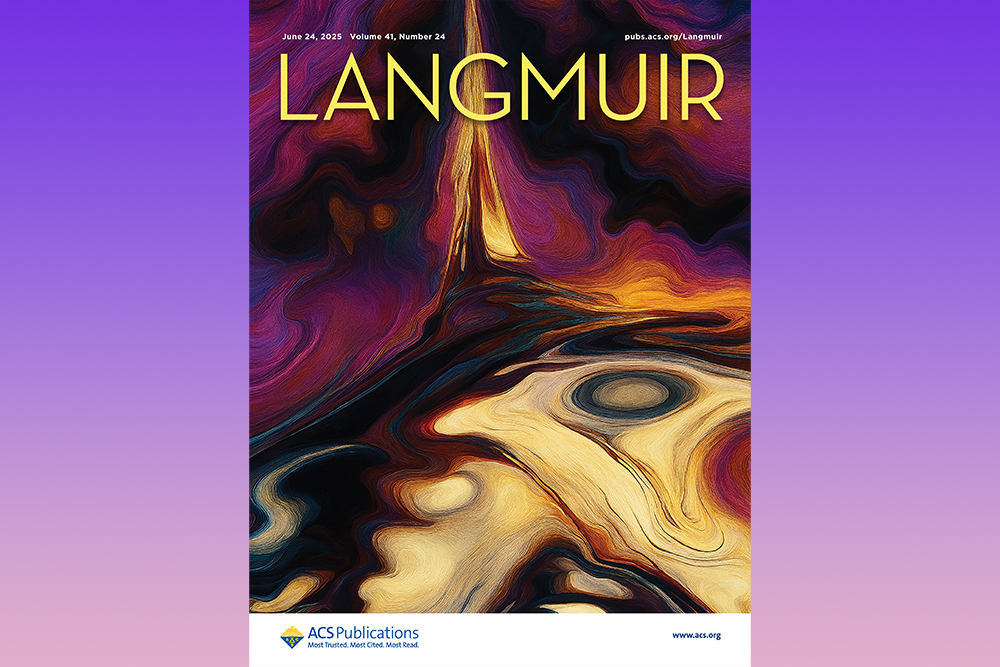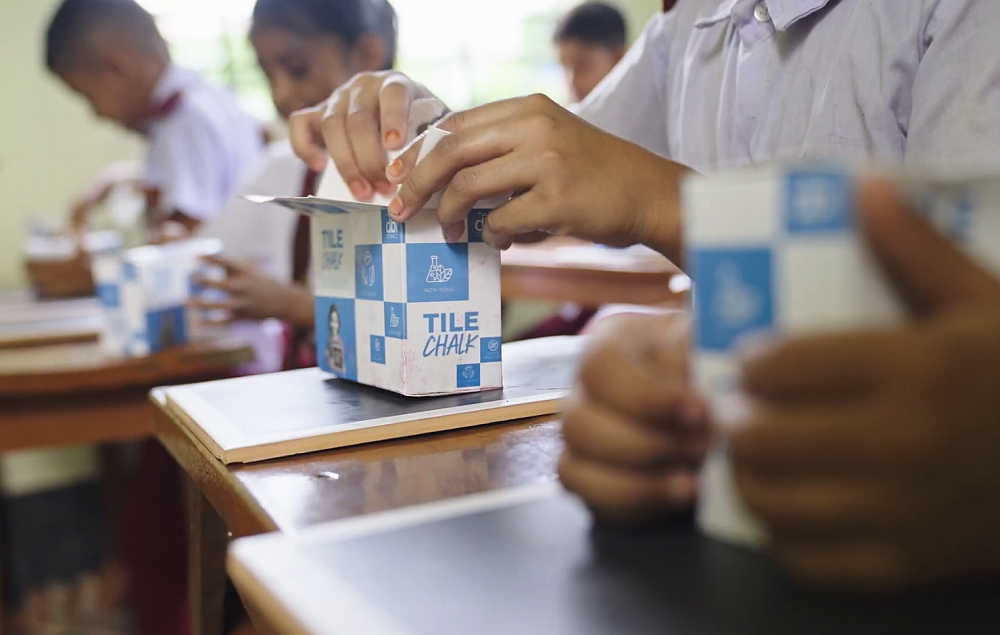
[Image above] A cross-polarized optical microscopy image of boron nitride nanotubes in aqueous surfactant dispersions (rendered with the assistance of AI tools). This image, which graced the cover of the journal Langmuir, illustrates a new method developed by Rice University researchers to create liquid crystals out of boron nitride nanotubes. Credit: Joe Khoury, Rice University
We spend thousands of hours staring at screens each year, but rarely do we think about the technologies that enable these ever-present devices. Of the many different display types on the market, liquid crystals remain the backbone of many television, laptop, and other handheld electronic screens.
Liquid crystals are substances that flow like a liquid but have some degree of ordering in the arrangement of their molecules. Liquid crystal phases are formed by a change in temperature (thermotropic) or by a change in molecular concentration (lyotropic). A third category of liquid crystal, metallotropic, has phase transitions that are driven by a combination of temperature, concentration, and the ratio of inorganic to organic components.
Most liquid crystals consist of organic molecules dissolved in a solvent. These types of liquid crystals are what make up our 4K and 8K television screens (thermotropic) and, perhaps surprisingly, the strong, lightweight Kevlar fabric (lyotropic).
Liquid crystals can consist of inorganic molecules as well. These types of liquid crystals offer distinct optical, electronic, and structural properties, but because they are a newer development, researchers are still working through challenges with controlling alignment and maintaining stability during fabrication.
When I first started writing this CTT, I didn’t expect my research into the background of liquid crystals to take me quite so deep into the weirdness of thermodynamics, nanoscale materials, entropy, and surface chemistry. But I am certainly glad it did because this knowledge allowed me to appreciate the beauty of the new, scalable method that researchers at Rice University developed to create liquid crystals out of boron nitride nanotubes.
Liquid crystal history
Liquid crystals were first described in 1888 by an Austrian botanist (or biochemist in modern terms), Friedrich Reinitzer, who was studying a cholesterol derivative extracted from carrots. He discovered that the material, cholesteryl benzoate, had two distinct melting points. It first transformed from a solid to a cloudy liquid at one temperature, and then to a clear, isotropic liquid at a higher temperature.
This cloudy liquid was determined to be a new state of matter. The term “liquid crystal” was coined by the physicist Otto Lehman in 1900, who called it flüssige Kristalle.
Science of liquid crystals
As noted earlier, liquid crystals have properties between those of conventional liquids and solid crystals. The organic and inorganic molecules that are dissolved in the solvent typically are elongated, rigid, and anisotropic (i.e., their properties are directionally dependent). This geometry allows them to align with a particular order, like a solid crystal, while still maintaining the fluidity of a liquid. That order takes three main forms—nematic (rods), smectic (plates), and cholesteric (helixes).
The ability of liquid crystals to self-assemble into intricate, highly ordered structures gives them a wide range of applications. In addition to displays for televisions and smartphones and synthetic fabrics for body armor, you might have seen liquid crystals in smart windows that change from transparent to opaque when an electric current is applied, in forehead thermometers, or as separation membranes.
Boron nitride nanotubes
Even though organic liquid crystals are the norm, early observations of lyotropic liquid crystal behavior involved inorganic colloids, such as vanadium pentoxide, and clay plates, for example, certain smectite clays, such as montmorillonite or vermiculite.
Boron nitride nanotubes (BNNTs), first fabricated in 1995, are the slightly younger cousins of carbon nanotubes. These materials are stepping into the spotlight by exhibiting liquid crystal behavior.
Unlike carbon nanotubes, which are metallic or semiconductors, BNNTs are electrical insulators with a wide band gap. They have high thermal conductivity, high mechanical strength, chemical stability, and neutron shielding capabilities. Their unique tubular, high aspect ratio (long and thin) shape is key to their ability to form liquid crystalline phases.
The ability of BNNTs to form inorganic liquid crystals was first documented in 2022. Liquid crystal formation allows for the processing and alignment of BNNTs into macroscopic materials with tailored properties, leveraging their unique characteristics such as high thermal conductivity, electrical insulation, and strength.
Fabricating liquid crystals from BNNTs
BNNT liquid crystals allow for the precise control of their orientation in macroscopic assemblies. This ordered arrangement translates the exceptional nanoscale properties of individual BNNTs into bulk materials, providing a wide range of advanced applications, particularly in ceramic technology and high-performance composites.
To create BNNT liquid crystals, the anisotropic BNNTs are dispersed in a suitable solvent (often with the help of surfactants to prevent aggregation), which drives them to self-assemble under interparticle interactions into liquid crystalline phases. Researchers can identify these phases using techniques such as polarized light microscopy, which reveals characteristic birefringent textures. In the case of BNNT liquid crystals, these textures are exceptionally beautiful.
Until recently, the fabrication of liquid crystals from BNNTs required harsh chemicals. However, the work done by the Rice University team offers a way to make BNNT liquid crystals in any laboratory with common chemicals.
In a Rice University press release, first author Joe Khoury says that previous fabrication attempts either worked at low BNNT concentrations or used too little surfactant.
“We showed that if you increase both in the right proportion, you can trigger liquid crystalline ordering without using harsh chemicals or complicated procedures,” he says.
They used sodium deoxycholate (SDC), a common surfactant, as the dispersant, which resulted in the successful fabrication of BNNT liquid crystals at SDC concentrations above 5 wt.% in water. Their method presents a less complicated, room-temperature process that can scale well in any laboratory. They also produced a comprehensive phase diagram for BNNTs in surfactant solutions. The phase diagram will allow scientists to anticipate how BNNTs will behave at different concentration ratios.
Perhaps the most interesting aspect of the team’s work is the artistic appeal of their polarized light microscopy images. They were able to observe the ordered structure of the liquid crystals as they developed. As a further step, they were able to process the liquid crystals into transparent, aligned thin films.
The future of BNNT liquid crystals
A scalable way to process BNNT liquid crystals and the phase diagram that predicts their behavior will enable increased exploration of the material properties. In turn, the applications of BNNT liquid crystals in specialty fields such as aerospace and high-purity membrane separation will continue to expand.
However, because making the BNNTs themselves remains an expensive process, the application of BNNT liquid crystals will be limited to high-margin fields, such as aerospace and precision electronics, for the foreseeable future.
The paper, published in Langmuir, is “Lyotropic liquid crystalline phase behavior of boron nitride nanotube aqueous dispersions” (DOI: 10.1021/acs.langmuir.5c00563).
Author
Becky Stewart
CTT Categories
- Manufacturing
- Material Innovations


